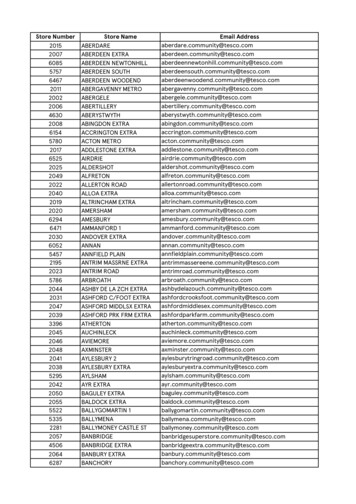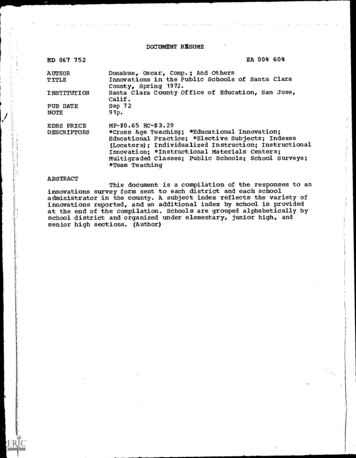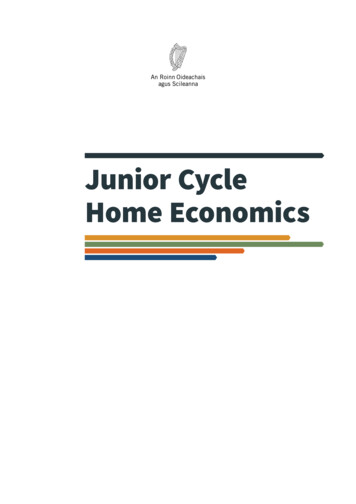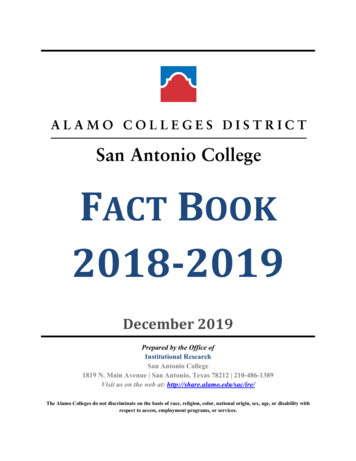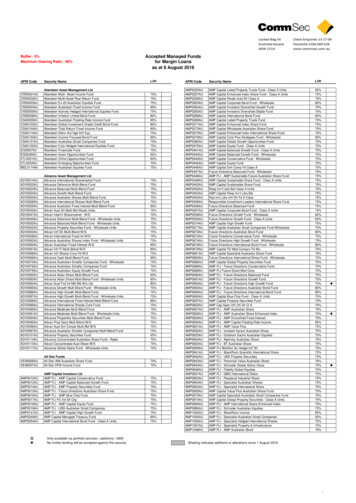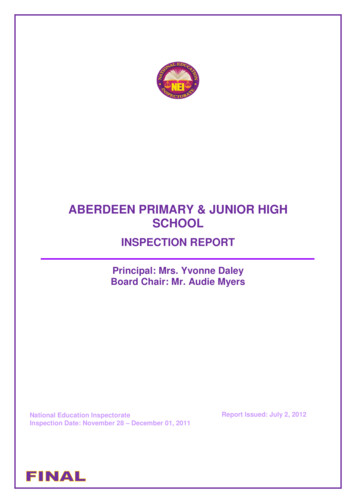
Transcription
ABERDEEN PRIMARY & JUNIOR HIGHSCHOOLINSPECTION REPORTPrincipal: Mrs. Yvonne DaleyBoard Chair: Mr. Audie MyersNational Education InspectorateInspection Date: November 28 – December 01, 2011Report Issued: July 2, 2012
TABLE OF CONTENTSPageIntroduction . 1Key Questions . 1The Five-point Scale . 2Consistency in terminology . 2Profile . 3School’s Demographics . 3Socio-economic Context . 3Executive Summary . 4Overall effectiveness of the school . 4Findings of School Inspection . 61) School Leadership and Management . 62) Teaching Support for Learning . 73) Students’ Academic Performance . 94) Students’ Academic Progress . 105) Students’ Personal and Social Development. 126) Use of Human and Material Resources . 137) Curriculum and Enhancement Programmes. 158) Student Safety, Security, Health and Wellbeing . 16Recommendations . 17Further Action . 17List of Abbreviations and Acronyms . 18Appendices . 19Appendix 1 - Record of Inspection Activities . 20Appendix 2 - Inspection Indicators. 21Appendix 3 - National Test Data . 40iiNational Education Inspectorate May 2013School Inspection Report
IntroductionThe National Education Inspectorate (NEI) is responsible for making an assessment of thestandards attained by the students in our primary and secondary schools at key pointsduring their education. It is the aim of the NEI to report on how well students perform orimprove, as they progress through their schooling and learning life. The NEI is also chargedwith the responsibility to make recommendations to support improvement in the quality of theprovision and outcomes for all learners.During school inspections, our trained inspectors observe classroom lessons, interviewmembers of the school’s staff, students individually and in small groups. Inspectors also lookat samples of student work and study various school documents provided before and duringthe inspection. Additionally, School Inspectors hold meetings with the principal and seniormembers of the staff to get clarity on their roles and responsibilities at the school.Please see the Inspection Indicators (Appendix 2) used by School Inspectors to assist informing judgements about a school’s progress.Key QuestionsThe inspection indicators are structured as a set of eight key questions that inspectors askabout the educational provision and performance of every school. These are:1. How effectively is the school led and managed by the Board, the principal and seniormanagement team and middle leadership?2. How effectively does the teaching support the students learning?3. How well do students perform in national and/or regional tests and assessments?(For infants: in relation to age-related expectations)4. How much progress do students make in relation to their starting points?5. How good is the students personal and social development?6. How effectively does the school use the human and material resources at its disposalto help the students achieve as well as they can?7. How well do the curriculum and any enhancement programmes meet the needs ofthe students?8. How well does the school ensure everyone’s security, health, safety and wellbeing?1National Education Inspectorate May 2013School Inspection Report
The Five-point ScaleInspectors make judgements according to a five-point scale. The five levels on the scale aredefined as follows:Level 5– Exceptionally high quality of performance or provisionLevel 4– Good. The expected level for every school. Achieving this level in allaspects of its performance and provision should be a realistic goal for everyschoolLevel 3– Satisfactory: the minimum level of acceptability required. All key aspects ofperformance and provision in every school should reach or exceed this levelLevel 2– Unsatisfactory: quality not yet at the level acceptable for schools. Schoolsare expected to take urgent measures to improve the quality of any aspect oftheir performance or provision that is judged at this level. Action on theinspectors’ recommendations for improvement is mandatoryLevel 1– Needs Immediate Support: quality is very low. Schools are expected to takeimmediate action to improve the quality of any aspect of their performance orprovision that is judged at this level. Action on the inspectors’recommendations for improvement is mandatory. These schools are also atrisk of direct interventions for improvement by the HME.Consistency in terminologyThe following terms are used consistently throughout the indicators with the followingdefinitions:AllAlmost allMostManySomeFewNone100%90% to 99%75% to 89%50% to 74%21% to 49%1% to 20%02National Education Inspectorate May 2013School Inspection Report
ProfileSchool’s DemographicsSchool Name:Locale:Parish:Region:Gender:School Code:School Organization:Size:Attendance Rate:Capacity:Enrolment:No. of Teachers:Pupil-Teacher Ratio:Multi-grade:Owned By:School Board:Aberdeen Primary and Junior HighRuralSt. Elizabeth5Co-educational11001Whole-dayClass II73%6002701421:1NoGovernmentActiveSocio-economic ContextThe Aberdeen Primary and Junior High School is named after the district in which it islocated. This district was named after the birth place of a Scottish plantation owner,Alexander Forbes of Aberdeen in Scotland. It is nestled in the hills of north-east St. Elizabethand is surrounded by lush green vegetation which provides a superb atmosphere that ishighly conducive to learning.Most students are from upper Aberdeen, north of the school. From here students travel forup to five (5) miles to reach school. The next significant number of students comes fromWilliamsfield to the south of the school. The rest of the school population comes fromThornton, Crown Land, Benlomonds and Lower Quick Step. A small number of the JuniorHigh students come from Siloah and its surrounding districts, including Coker and Barton.Students travel to school on taxis, private vehicles, minibuses, bicycles and on foot.Most parents are either subsistence farmers or housewives and are of a low socio-economicstatus. As a predominantly farming area many students help their parents on the farm.During cane season some students stay away from school and many do not attend schoolevery day of the week as their parents cannot afford to send them. Despite many parents’inability to provide much for their children, some endeavour to send their children to schoolwith the assistance provided by the school’s lunch and breakfast programmes or thegovernment’s Programme of Advancement Through Health and Education (PATH), whichsupports 166 students.3National Education Inspectorate May 2013School Inspection Report
Executive SummaryOverall effectiveness of the schoolThe overall effectiveness of Aberdeen Primary and Junior High School isunsatisfactoryLeadership and management is unsatisfactoryProgrammes undertaken are not efficiently monitored or structured. Lesson observations arecarried out once per month with no evaluative comments to guide teachers for futureplanning. There is no documentation for some programmes including review or modificationof the curriculum. However, the fully constituted Board plays both an advisory and supportiverole as it develops good relations with all staff. Parental support is given by some committedparents, but they are mostly with children in the lower grades.Teaching and learning is unsatisfactoryStudents’ interests are captured and provision to cater to their different abilities is moreevident in the primary department. The main method of teaching especially in the upperschool is ‘chalk and talk’. There is no structured assessment programme in place to measurethe level of performance in a continuous way. Students in the upper grades show very littleinterest in learning while students at the primary level are highly motivated to learn anddisplay confidence.Performance in English and mathematics is unsatisfactoryThe overall trend observed throughout the period under review for English for all externalexaminations was unsatisfactory. The performance trends for numeracy at Grades 4 andmathematics in the Grade Six Achievement Test were always below the national averages;while at Grade 9 performance moved from being equal to the national average to below.Females out-performed males over the years in GSAT and Grade Nine Achievement Test(GNAT).Progress in English and mathematics is unsatisfactoryAs a school some progress is seen over the last two years, however many students are notperforming at their best. Progress in lessons is reasonable for some students in Grades 1 to6 but unsatisfactory for Grades 7 to 9. This is reflected in the improvements made at theGrades 4 and 6 levels in external examinations, but progression up to Grade 9 continues tobe a struggle.Overall, students’ personal and social development is unsatisfactoryMost students, especially in the primary department, are well behaved as observed fromtheir mannerly actions, however, some students in the secondary department display antisocial behaviours. Average attendance over the last three years is 73 per cent which isinadequate for secure curriculum coverage. Many students display some knowledge ofnational symbols, but had limited knowledge of current affairs such as the name of theMinister of Education. Economic and environmental awareness while adequate for localissues was lacking for many students as it relates to regional and global matters.4National Education Inspectorate May 2013School Inspection Report
The school’s use of its human and material resources is unsatisfactoryThe quality and quantity of material resources are unsatisfactory including reading booksand computers for students as well as furniture for staff. Teachers have some materials attheir disposal but these are not well utilized. Nevertheless, the academic staff is suitablyqualified and there are sufficient support staff in place to assist in the efficient managementof the school. Teachers attend school regularly and many are punctual.Curriculum and enhancement programmes are unsatisfactoryThe school uses two curricula to support teaching. These are the Revised PrimaryCurriculum (Grades 1 to 6) and the Reform of Secondary Education (ROSE) curriculum(Grades 7 to 9). These can provide a holistic approach to learning but there is insufficientmodification to ensure maximum learning for all students. There is greater progression andcoverage in the curriculum used by the primary department. Teachers meet once per weekfor common planning time to review topics some of which are broken down to suit the abilityof most students. There is no evidence to show that extra-curricular activities play ameaningful role in students’ learning and personal development as most clubs are inactive.After-school classes are held but these are not doing well as not many students attendregularly.Provisions for safety, security, health and wellbeing are satisfactoryWhile the school lacks formal policies in these areas, there are well known procedures forpromoting health, safety and wellbeing. There is perimeter fencing and a gate that iscontrolled by security guards who issue entry and exit permits to visitors and students andprovide security for the school. Sixty-one per cent of the students benefit from theGovernment’s PATH Programme as well as the school’s internal interventions.Inspectors identified the following key strengths in the work of the school: The school is relatively safe and secure Staff and student relationships are generally cordial Spacious and individualized classrooms provide sufficient space for teaching andlearning activitiesHow effective is the school overall?The overall effectiveness of the school is unsatisfactory5National Education Inspectorate May 2013School Inspection Report
Findings of School Inspection1) School Leadership and ManagementHow effectively is the school led and managed by the Board, the principal andsenior management team and middle leadership?Overall, leadership and management is unsatisfactorySchool-based leadership and management is unsatisfactoryThere are good relations throughout the school community. And, the school’s vision, which isprominently displayed at the front of the school, is shared with key stakeholders at variousmeetings. The key focus is on the holistic development of students. However, the strategiesto achieve the vision are limited and lack sufficient structure to ensure success. Forexample, there is recognition of the need to enhance the development of boys but there isno structured programme in place to achieve this.Instructional leadership is weak. Teachers are evaluated and most are judged satisfactory bythe school; however, there are significant weaknesses in teaching methods and assessmentpractices. Lesson observations are carried out once per month, however, evaluativecomments are not provided to guide teachers towards improving lesson delivery.The leadership attempts to be collaborative by holding monthly staff meetings andestablishing committees to support the operations of the school. However, this has notyielded the desired results as only the Guidance and Counselling or Safety and Securitycommittees, have met since the start of this school year.Self-evaluation and school improvement planning is unsatisfactoryWhile the school is able to identify some of its strengths and weaknesses, there isinsufficient planning to ensure improvement in these areas. For example, the teaching ofmathematics is a challenge but no structured programme is in place to remedy this situation.There is no documentation for some programmes including review or modification ofcurricula. Activities for self-evaluation include school tests, external examinations anddiagnostic tests but this lacks sufficient organisation, detail and focus to yield the depth ofinformation necessary to drive meaningful school improvement. Staff appraisal is donetermly for weak and new teachers and once per year for others.Governance is satisfactoryThe fully constituted Board of Management plays both advisory and supportive roles whichaid in maintaining good relationships among all stakeholders. The Board meets bi-monthlyand is satisfied with the staff’s performance. They are especially proud of the fact that theyonly had to deal with one disciplinary incident with a student during all of the last schoolyear. The school leaders are expected to provide clear reports on school finances, studentand staff performance. The Board is not satisfied with students’ performance at the nationallevel and held a meeting with the parents recently in an effort to get them more involved intheir children’s academic lives. It is concerned that the numeracy target is set too low toachieve the national target of 85 per cent by 2015.6National Education Inspectorate May 2013School Inspection Report
Relationship with parents and local community is unsatisfactorySome parents visit the school to enquire about their children’s performance, but in general,more support is given from parents with children in lower school than in the upper grades.The Administration feels that far more input is needed from parents in the academicperformance of students especially with homework if students’ performance is to improve.Parents have concerns about the behaviour and attitudes of students especially as it relatesto punctuality. Some parents make a special effort to support the school’s activities. RegularParent Teachers’ Association (PTA) meetings are held with good relationship between theschool and community which is seen as protective. Assistance to the school with safety andhealth issues comes from the Police, Fire and Health departments.How effectively is the school led and managed by the Board, the principal and seniormanagement team?1-9GradesSchool-based leadership and managementUnsatisfactorySelf-evaluation and improvement ons with parents and communityUnsatisfactory2) Teaching Support for LearningHow effectively does the teaching support the students’ learning?Overall, teaching in support of learning is unsatisfactoryThe teachers’ knowledge of the subjects they teach is unsatisfactoryAt the primary level most teachers are knowledgeable about the subjects they teach. At thislevel, the interests of many students’ are captured and provision made as they work ingroups according to ability. However, some teachers in the secondary department do notexhibit a good command of the English Language. Most of the students’ communication isalso limited to the use of the Jamaican Creole. Limited provision is made to facilitatedifferentiated learning at the secondary level as all students are taught as a homogenousgroup. There are more boys than girls in most classes yet there is no planned activity tostimulate learning among these boys. Continuous reflection on lesson delivery is weaker inthe secondary department of the school and this is directly linked to the quality of instruction.Teaching methods are unsatisfactoryThere is an obvious difference in the preparation of lesson plans of most teachers betweenthe primary and secondary departments of the school. While some teachers write detailedlesson plans, they generally do not cater for the different abilities of the students. Objectives7National Education Inspectorate May 2013School Inspection Report
are sometimes general and procedures unclear, therefore some classes are disorganisedand learning is limited. In the upper school, teacher-centred methods which fail to capturethe students’ interest; especially the boys are mostly used. Many lessons also indicateconcepts that are not aligned to students’ experience.Throughout the school, time is poorly managed and timetables are not adhered to. In somelessons, this affects the completion of tasks and assessment activities. In some lessons;especially in the upper grades, there is no use of relevant teaching aids such as audiovisuals to enhance lessons. This was a marked difference to the primary department whereteachers use a variety of resources to enhance learning and students relate to concepts asthey transfer prior knowledge to enrich the teaching and learning process. Student-teacherinteraction is often not well managed enough to ensure that it stimulates meaningfuldiscussions. Questioning techniques used by most teachers are not sufficiently challengingand in most instances, the students tend to respond in chorus.Students’ assessment is unsatisfactoryTeachers are aware of the need to have assessment records as they all have mark bookswith students’ test scores, but there is no real structure to guide how this information is usedto measure the level of students’ performance in a continuous way. At the class level,assessment is done but little provision is made for re-teaching concepts even for the benefitof slow learners or students who did not master concepts. Some students’ workbooks haveno written feedback from teachers even where there are errors. Where alternative means ofassessment such as journals and portfolios exist, students are unable to outline their clearpurpose. Some teachers are also unable to clearly highlight how these are used to assessprogress. Whilst test records are present; there is no analysis of these records. Assessmentactivities are written in all the lesson plans and in most cases they are related to the lessonobjectives but the information from this is not used to inform future planning.Student learning is unsatisfactoryStudents in the upper grades show very little interest in learning and are especially weak inmathematics. Most students in the primary department are highly motivated to learn anddisplay confidence when completing given tasks. They are not afraid to pose questions andrespond to questions. However, some teachers do not encourage students’ initiative andexploration in problem-solving areas. Some students especially at the primary level arechallenged to stretch themselves and proudly share their experiences with their classmateswho listen attentively. There is evidence of transfer of previous knowledge to bringunderstanding to present reality.8National Education Inspectorate May 2013School Inspection Report
How effectively does the teaching support the students learning?1–67–9Teachers’ subject knowledge and howbest to teach the subjectUnsatisfactoryUnsatisfactoryTeaching radesStudents learning3) Students’ Academic PerformanceHow well do the students perform in national and/or regional tests andassessments?Overall, students’ performance is unsatisfactory in national testsStudents’ performance in English is unsatisfactoryThe school’s performance has fluctuated in the Grade Four Literacy Test. In 2008, theschool’s average mastery of 62 per cent was below both the national and regional averagesof 69 and 66 per cent respectively. In 2009, the average mastery fell to 55 per cent areduction of seven per cent from the previous sitting. This was 12 percentage points belowthe national average. However, in 2010 the average mastery of 67 per cent was slightlyabove the national and regional averages. The Grade Four Literacy target set for eachprimary level school by the Ministry of Education (MoE) is 100 per cent mastery; this is to beachieved by 2015. Therefore, Aberdeen Primary and Junior High will need to increase itsaverage by 8 per cent each year to meet the target.The school’s performance in The Grade Six Achievement Test (GSAT) language arts andcommunication task examinations has improved in recent years, but is yet to reach therequired standards. Over the period of focus (2008 to 2011) the schools average scores inlanguage arts have been consistently below the national averages. For most of the periodthe scores have been in the forties while the national averages have been 53, 57, 58 and 58per cent respectively. In communication task there has also been improvement. In 2008, theaverage was 58 per cent; equal to the national average. In 2009, this fell to 50 per cent, butin 2010 the score was again 58 per cent. In 2011, there was dramatic improvement and theaverage was 75 per cent. This was above the national average of 67 per cent. For languagearts, the gender achievement gap showed that girls outperformed boys. The gap was narrowin 2008, however, by 2011, the gap was much wider. For communication tasks, the gapwidened towards the end of the period with girls again doing much better than the boys.The school’s average in language arts in the Grade Nine Achievement Test (GNAT) over thesame period 2008 to 2010 was inadequate. In 2008, the school’s 47 per cent was equal othe national average. However n 2009, the national average was above the school’s 46 percent by 6 percentage points. In 2010, the school’s performance remained the same (46%)9National Education Inspectorate May 2013School Inspection Report
and the national average was above this at 49 per cent. Similar to the Grade 6 level, girlsoutperformed the boys.Students’ performance in mathematics is unsatisfactoryThe school’s performance in the Grade Four Numeracy Test (GFNT) has been substandard.In 2009, the average mastery was 35 per cent; this was below the already low nationalaverage of 42 per cent. In 2010, this decreased to 30 per cent and was 8 percentage pointsbelow the national average. The Grade Four Numeracy target set by the Ministry ofEducation is 85 per cent by 2015. The school will have to increase its average by 14.2 percent each year to achieve this target.In all four years the school performed well below the national average in GSAT. In 2011 theiraverage of 55 per cent was 11 percentage points below the national average. At the GradeNine level the school’s performance fluctuated. In 2008 the performance was on par with thenational average (40%). In 2009 it fell below, and in 2010 their 41 per cent exceeded thenational average of 40 per cent. The gender achievement gap indicated that for all gradelevels the girls out-perform the boys. The gap was extremely narrow at the beginning of theperiod (2008) and gradually widened towards the end of the period (2010).How well do the students perform in national and/or regional tests and UnsatisfactoryUnsatisfactoryGradesHow well do the students perform inNational or regional tests andexaminations in English?eHow well do the students perform inNational or regional tests andexaminations in mathematics?l4) Students’ Academic ProgressHow much progress do the students make in relation to their starting points?Overall, students make unsatisfactory progress in relation to their startingpointsStudents’ progress in English is unsatisfactoryThe 2005 cohort made little progress over the period when compared to the performancenationally. The average readiness for this cohort was 69 per cent; three percentage pointsabove the national average. In 2009, the cohort’s average in the Grade Four Literacy Testwas 55 per cent while the national average was 67 per cent. Based on the averagereadiness at entry point in Grade 1, the cohort did not make expected progress. In 2011, thecohort’s average in language arts in the GSAT was 57 per cent almost on par with thenational average of 58 per cent.The school made satisfactory progress in performance at the GFLT and even betterprogress in communication task in GSAT. Aberdeen achieved an average of 62 per cent in10National Education Inspectorate May 2013School Inspection Report
the Grade Four Literacy Test in 2008 but made no progress in 2009 (55%). Progress washowever made in 2010 (67%). Performance was stable in the GSAT language artsexamination in 2008 and 2009; little progress in 2010 but significant progress in 2011 (57%).No overall progress was seen in performance in the GNAT exam. The school’s performancewas on par with the national average in the GNAT in 2008 (47%) and made no progress in2009 and 2010 (46%) for both years. Progress during lessons is satisfactory for Grades 1 to6 but unsatisfactory for Grades 7 to 9. In these upper grades, most students perform belowaverage and some fail to attain appropriate levels during lessons.Students’ progress in mathematics is unsatisfactoryMany students of the 2005 cohort entered Grade 1 with averages that were well above thenational score, the progress at Grades 4 and 6 was below acceptable standards. The overallaverage readiness for the 2005 Grade 1 cohort in the Grade One Readiness Inventory was69 per cent, three percentage points above the national average. Number Letter Knowledgeaverage was 70 per cent, thirteen percentage points above the national average. In 2009,the cohort average performance in the Grade Four Numeracy Test was 35 per cent, whichwas below the national (42%) and regional averages (40%); expected progress was notrealized. In 2011, the cohort averaged 55 per cent in GSAT was seven percentage pointsbelow the national average.The performance trends at Grades 4 and 6 were always below the national averages whileat Grade 9 performance moved from par to below the national averages. Females outperformed males over the years in GSAT and GNAT. The school did not make any progressin the Grade Four Numeracy Test in 2009 (35%) and 2010 (30%). No progress was made inthe GSAT during the period 2008 (44%) to 2009 (38%) but significant progress was madeduring the period 2010 (45%) to 2011 (55%). No progress was made in the GNAT during theperiod 2008 (40%) to 2009 (38%); some progress was however made in 2010 (41%); onepercentage point above the national average.Progress during class is unsatisfactory except at Grade 4 where some students transitionedfrom place value and addition of fractions to addition of mixed numbers successfully. Workgiven for the grade level is appropriate. Little meaningful progress is seen at Grades 7 to 9where students are mostly slow learners and are insufficiently stretched to advance theirreasoning abilities.How much progress do the students make, in re
School's Demographics School Name: Aberdeen Primary and Junior High Locale: Rural Parish: St. Elizabeth Region: 5 Gender: Co-educational School Code: 11001 School Organization: Whole-day Size: Class II Attendance Rate: 73% Capacity: 600 Enrolment: 270 No. of Teachers: 14 Pupil-Teacher Ratio: 21:1 Multi-grade: No Owned By: Government School .


